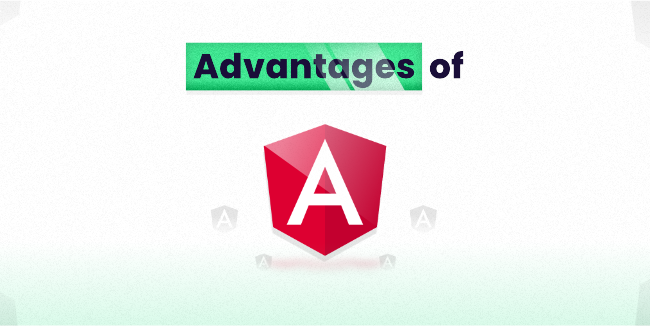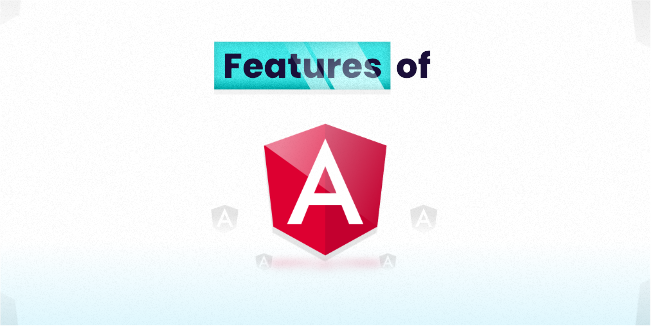Web Development
Technologies
What is the Angular framework?

Nowadays, being online is crucial for any business. For consumers, the existence of a website of a given enterprise is its credibility. It also works the other way around: if a company does not have a website, then in the eyes of consumers, such a company ... does not exist. It is not surprising that web application development services are popular and more and more accessible to a wide audience.
Our vast portfolio shows that creating web applications is only seemingly an easy task. The creators of the web app very often focus only on the visual side but forget about the users' expectations. Meanwhile, a good product should combine UX/UI design and performance because only such a combination guarantees recognition in the eyes of consumers. Knowledge about product design is necessary for any software development project!
Another important factor is choosing the proper tech stack that will be selected appropriately for your project. As a web application development company, we believe that combining technology and passion can have a remarkable effect. So if you want a lightweight and fast web application, learn more about Angular - one of the best frameworks for building web applications.
What is Angular?
Angular is an open framework and platform for creating Single Page Applications, written in TypeScript and supported and developed by Google. Angular was initially supposed to be version 2 of the popular AngularJS framework. Still, design decisions made Google decide to release it as a separate entity, including the lack of backward compatibility and the simple update path of applications written in AngularJS to Angular 2. Angular is released under the MIT license. Angular has apparent advantages as a framework while also providing a standard structure for developers to work with. It enables users to create large applications in a maintainable manner.
A brief history of Angular and AngularJS
The Angular journey started in 2010 when AngularJS was introduced, and the framework has now evolved to Angular 12 with many enhancements over the years.
AngularJS is one of the most popular JavaScript frameworks. Miško Hevery and Adam Abrons developed it as part of a Google project in 2009. In 2010 AngularJS was introduced as an open-source framework. It's been a huge success. Users have downloaded the app and begun developing unique applications for it. The Ionic Framework, developed on top of Apache Cordova from Ionic (formerly DriftyCo), really gave developers an incentive to create mobile apps using AngularJS.
Some of the most well-known businesses started to include it in their toolset for web development: Netflix, NBC, Walmart, and Forbes.
The development landscape changed after a few years, and AngularJS hit a wall. Angular began to fall behind as discoveries and standards in JavaScript emerged. More significantly, the core team had hit a wall when expanding Angular's functionality to meet the growing needs.
In May 2016, emerged Typescript was shown together with Angular 2. This version of Angular was a complete rewrite of the framework, attempting to address some of the issues with the original. The development process for Angular 2 was arduous and lengthy, but it paid off. Angular 2 is now a modern, well-architected framework that addresses many of the shortcomings of AngularJS. From then on, subsequent versions were to be released in 6-month cycles.
Angular 3, however, did not appear. Angular 4 was released on March 23, 2017, reducing bundle size.
- In November 2017: Angular version 5 with Add-on Features
- In May 2018: Angular 6 and introducing feature-complete frame
- In October 2018: Angular 7 with Virtual Scrolling, Drag and Drop, Application performance
- On May 28, 2019, Angular 8 appeared with a new test compiler code named Angular Ivy and featuring differential loading for all application code, dynamic imports for lazy routes.
- In 2020, three more versions appeared: Angular 9 (in February 2020), Angular 10 (in June 2020), and Angular 11 (in November 2020) with faster builds and loading.
- In 2021: Angular 12, Styling improvements.
What is Angular used for?
JavaScript is the most frequently used client-side web applications programming language. It's embedded into HTML documents to enable interactions with online pages in various ways. It's a simple, easy-to-learn language that's well-suited to creating modern apps due to its widespread support. Is JavaScript the best language for building modular, testable, and productive single-page apps? Perhaps not.
We now have a plethora of frameworks and libraries to help us achieve our goals. Angular, as an example, is a framework that addresses many if not all of the problems developers encounter when utilizing JavaScript on its own. Angular developers can create web apps, SPA, and PWA.
Advantages of Angular

Supported by Google
Google endows Angular with Long-Term Support (LTS) is one of the most significant benefits. Google offers long-term support for Angular, which sheds light on Google's plan to keep using the framework and expand the Angular ecosystem. Google also employs Angular and has high confidence in its stability.
TypeScript
Angular applications are built using TypeScript language, a superscript for JavaScript. The advantage of using this approach is that it allows for optimal code quality, making the application more secure. It aids in detecting and eliminating mistakes early on while writing the code or performing maintenance operations.
Declarative UI
An Angular application's user interface (UI) is built using HTML. When compared to JavaScript, HTML is a more straightforward language. It's also a declarative and easy-to-use language, with directives such as ng-app, ng-model, etc.
With its assistance, you won't have to spend time creating program flows and deciding which items should come first. Describe what you want, and Angular will handle the rest.
POJO (Plain Old Java Object)
You don't need any extra getters and setters in Angular. This is because every object Angular employs is a POJO, which allows for object manipulation via all of JavaScript's normal functionalities. You can remove or add properties from the things while also iterating over them as needed.
SPA and PWA
A Progressive Web App (PWA) is a cost-effective method for websites to behave like mobile apps. It lowers the network requirement, improving the website user experience.
When utilizing the server-side rendering capabilities of Angular, single-page web applications (SPA) may be written. It also aids in loading the home page quickly and improves website performance on mobile and low-powered devices.
Simplified MVC Pattern
The Angular framework is embedded with the original MVC, but it's more of an MVVM software architectural setup. Angular does not ask developers to split an application into different MVC components and build a code that could unite them.
Its framework uses the MVVM(Model-View-ViewModel) architecture better than an MVC (Model-View-Controller) one. The MVVM model supports two-way data binding between View and ViewModel. It allows the automatic propagation to change within the ViewModel's state to the view. Typically, ViewModel uses the observer model to inform changes to the ViewModel model to model.
Modular Structure
Angular groups source code into buckets, such as Angular components, directives, pipes, and services. Modules are named for those who are acquainted with Angular. Modules allow you to structure your application's features and reusable portions efficiently. Modules also make lazy loading, which will enable applications to load features in the background or on-demand.
With the help of Angular, you may develop a complex app while dividing work and ensuring organized code. When you have a solid grasp of these, you may make the most of the modules. Modularization might enhance developer efficiency in certain situations.
Code Consistency and Easy Testing
The Angular framework is built on components that all start simultaneously. Each component, for example, enters the code into a component class or uses the @Component decorator (metadata). This component class is tiny interface elements that aren't dependent on each other and provide you with several advantages, including:
- Reusability: The component-based architecture of Angular allows components to be reused across the app with ease. Developers can develop the UI (User Interface) while ensuring a smooth development process.
- Simplified Unit-Testing: Components that interact with each other should be kept separate, making unit testing a lot simpler.
- Improved Readability: Coding consistency makes reading the code a breeze for newer developers on an ongoing project. It increases their productivity and efficiency throughout the project.
- Ease of Maintenance: Decoupled components offer high configurability and may be upgraded if better versions become available. Simply put, it allows for efficient code modification and maintenance.
Also, testing in Angular is simple. The application components of Angular.js modules are straightforward to change. You may load the required services while performing automatic testing using module separation. If you adhere to the "one file-one module" guideline, you don't have to remember the module loading sequence.
The Angular ecosystem consists of a diverse group of over 1.7 million developers, library authors, and content creators. Before exploring the Angular platform, you should know about Angular CLI. The Angular CLI is the fastest, easiest, and recommended way to develop Angular applications. The Angular CLI makes a good starting point because it provides a much quicker development process for Angular projects. Additionally, Angular is designed to make updating as easy as possible so that you can take advantage of the latest developments with a minimum of effort.
Features of Angular

Document Object Model
The Document Object Model (DOM) views an XML or HTML document as a tree, with each node representing a portion of the text. The DOM in Angular is similar to that in other frameworks. Consider a scenario in which ten changes are made to the same HTML page. Instead of updating only those that have already been updated, as would be done with conventional DOM, Angular will update the entire tree structure of HTML tags.
TypeScript
TypeScript provides a set of types to JavaScript that may help people write code that is easier to understand. TypeScript code compiles and runs on all platforms without issue. Developing an Angular application does not require users to use TypeScript. However, it is strongly suggested that it improves syntactic structure while making the codebase more simple to understand and work with. It's recommended to code Angular apps in TypeScript.
Data Binding
Data binding is a method of interacting with web page components using a browser. It uses dynamic HTML and does not require sophisticated scripting or programming. Data binding is employed in web pages with interactive features, such as calculators, tutorials, forums, and games. When a website has a lot of data, it enables better incremental viewing by displaying only part of the content.
Two-way binding is a feature of Angular. The model's state is updated when changes are made in the corresponding UI components. In contrast, the UI state reflects any modifications to the model data. This capability allows the controller to connect the DOM to the model data via the framework.
Testing
Angular uses the Jasmine testing framework. The Jasmine architecture provides various features for creating different sorts of test cases. Karma, the test task-runner, utilizes a configuration file to define the start-up conditions, reporters, and testing framework.
Angular Architecture

Now that you've gotten a handle on the fundamental aspects of Angular, it's time to learn about its architecture if you want to utilize it regularly.
Angular is a model-view-controller (MVC) framework in its purest form. It gives clear instructions on how the application should be organized, bi-directional data flow, and proper DOM support.
Modules
An Angular application has a root module, called AppModule, that serves as the bootstrapping mechanism for launching the app.
Components
A component is a self-contained unit of code and data bundled together as a single unit to execute an application. A component generally refers to a user interface section (UI). Angular's component model offers strong encapsulation and an intuitive application structure. For example, Angular Material is a UI component library that implements Material Design in Angular.
Templates
The template for the Angular app uses HTML and Angular markup to modify web page elements before they are displayed. There are two types of data binding:
- Event binding: Allow your app's data to be updated in the target environment by responding to user input.
- Property binding: Enables users to translate information obtained from your application's data into HTML.
Metadata
The metadata tells Angular how to handle a class. It is used to decorate the class to control the expected behavior of the class.
Services
Service classes are used to share data or logic that isn't linked with the view but needs to be shared across components. The class is always decorated with the @Injectible decorator.
Dependency Injection
Dependency injection is a mechanism that lets you keep your component classes short and to the point. It does not check for validity of user input, log to the console immediately, or access data from a server. Instead, it hands off such operations to services.
Conclusion
Angular is already a top-rated web application framework, according to Statista. It represents that Angular is one of the industry's leaders in web construction platforms and a popular selection for significant enterprises. It's a framework designed for developers and companies looking to create cutting-edge applications.
We are a successful Angular development business, so we can always provide you with web and mobile application development services and share our knowledge. You may also contact us if you want to outsource your Angular project.